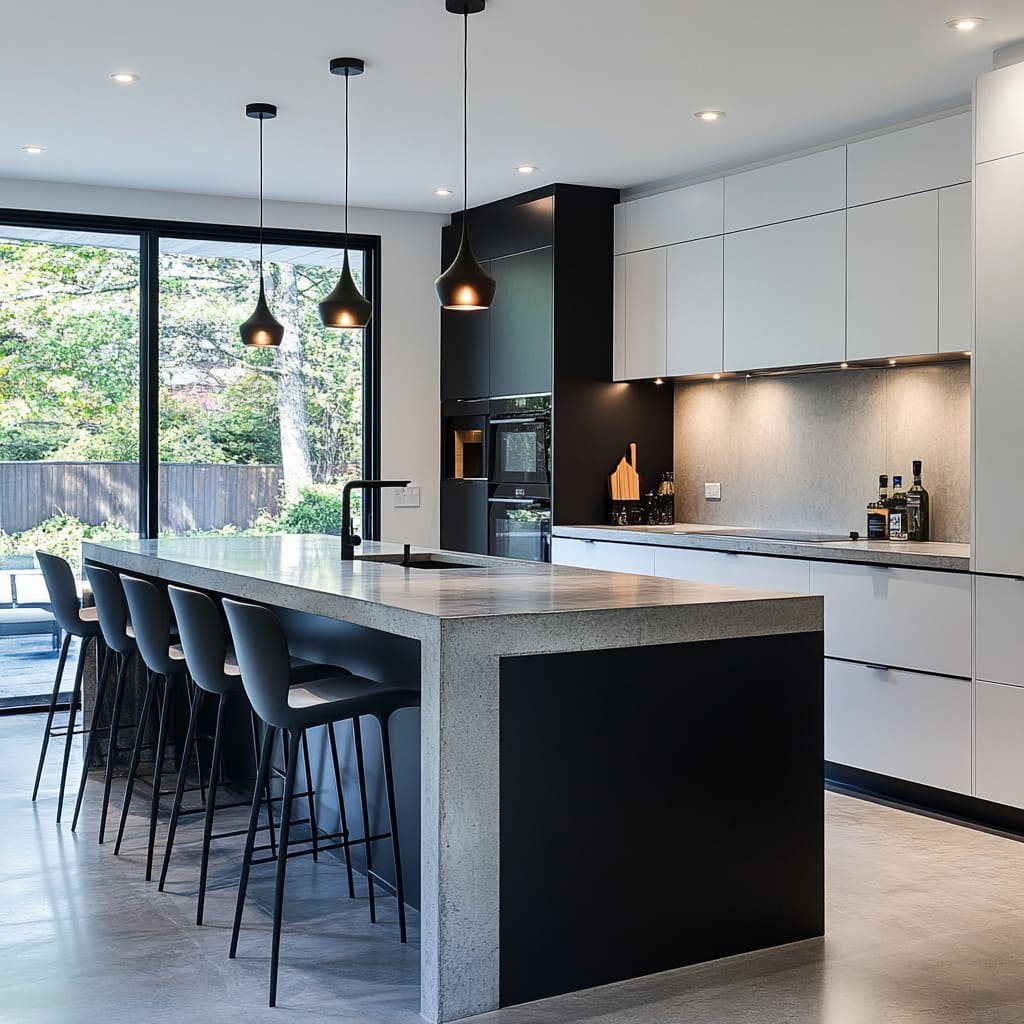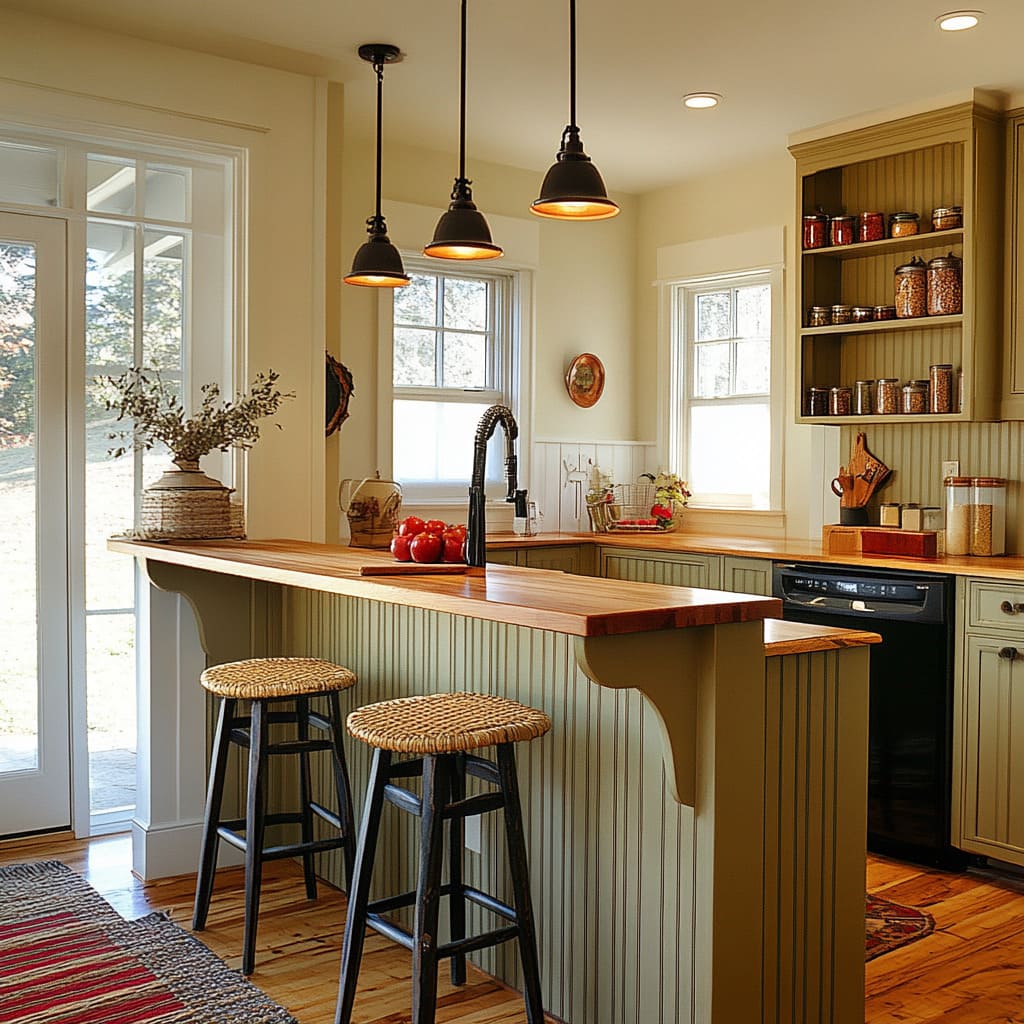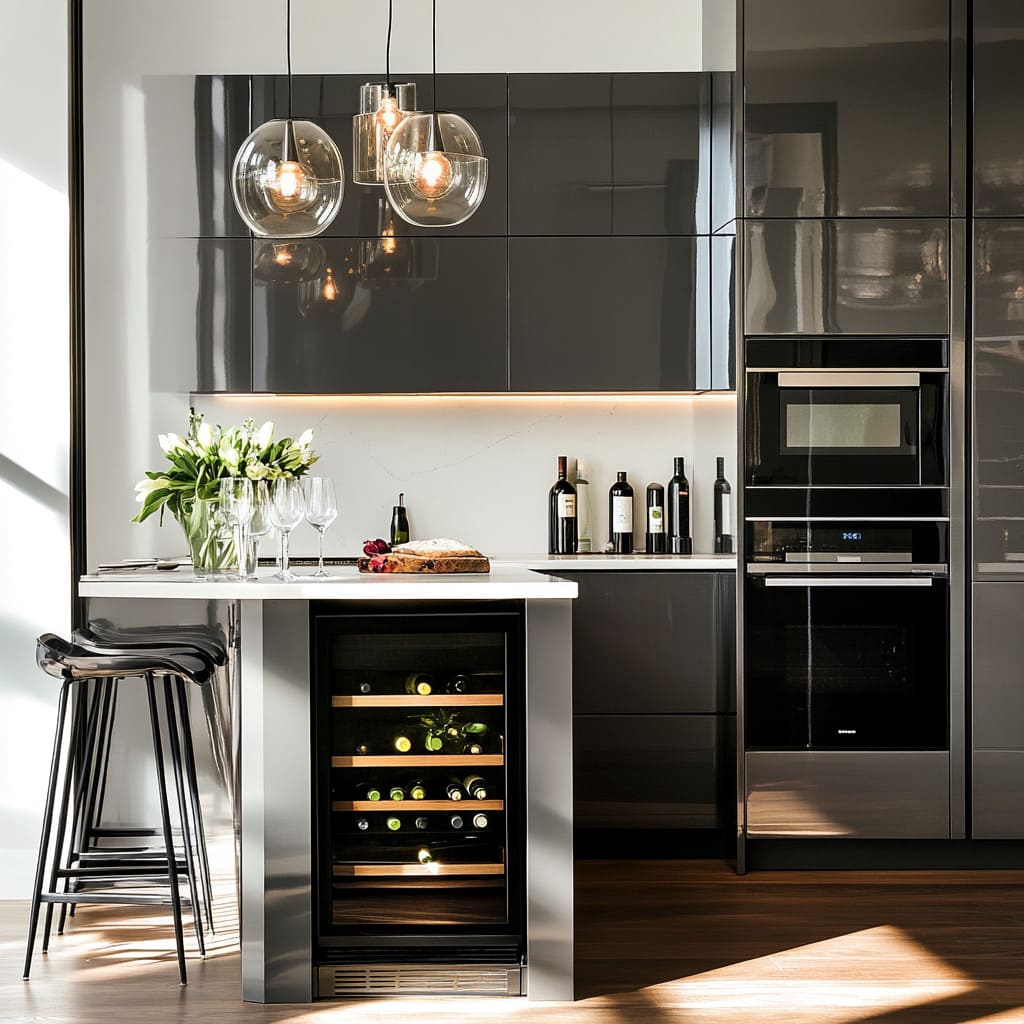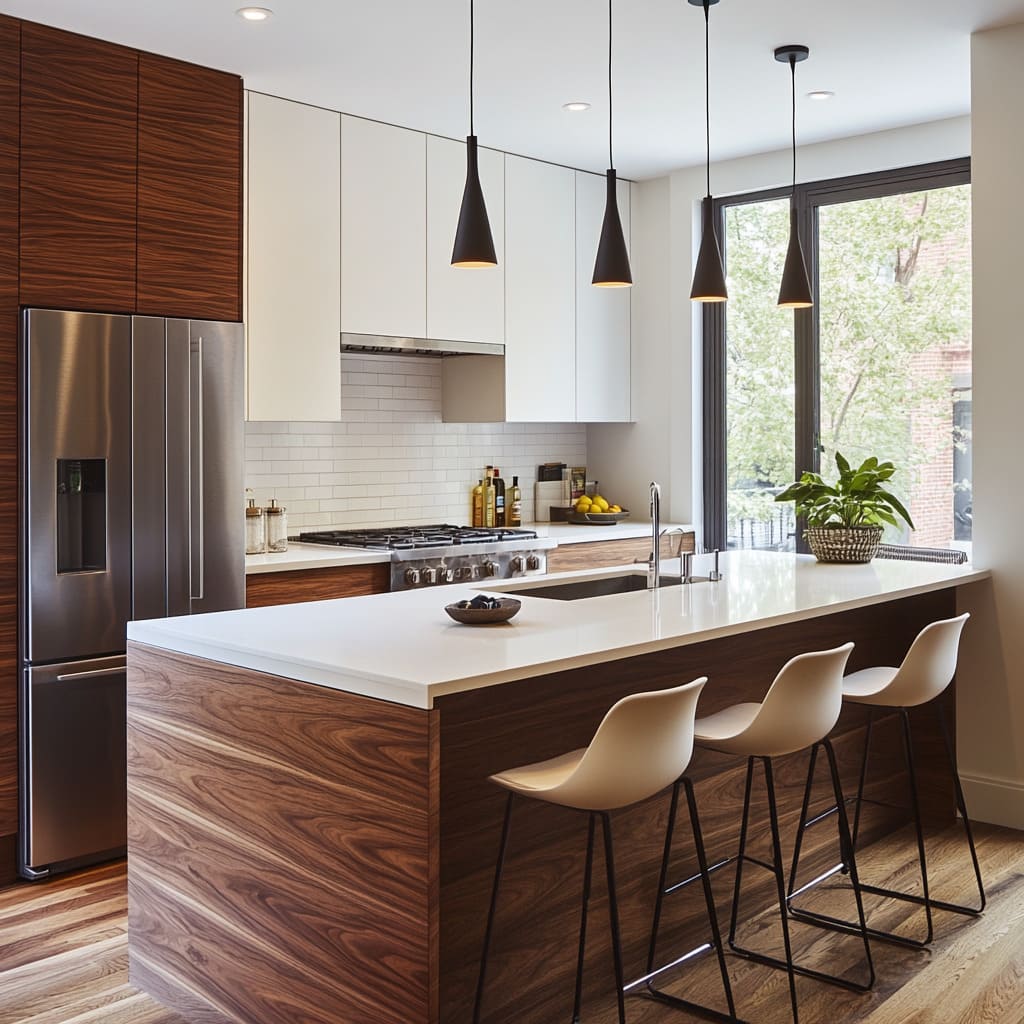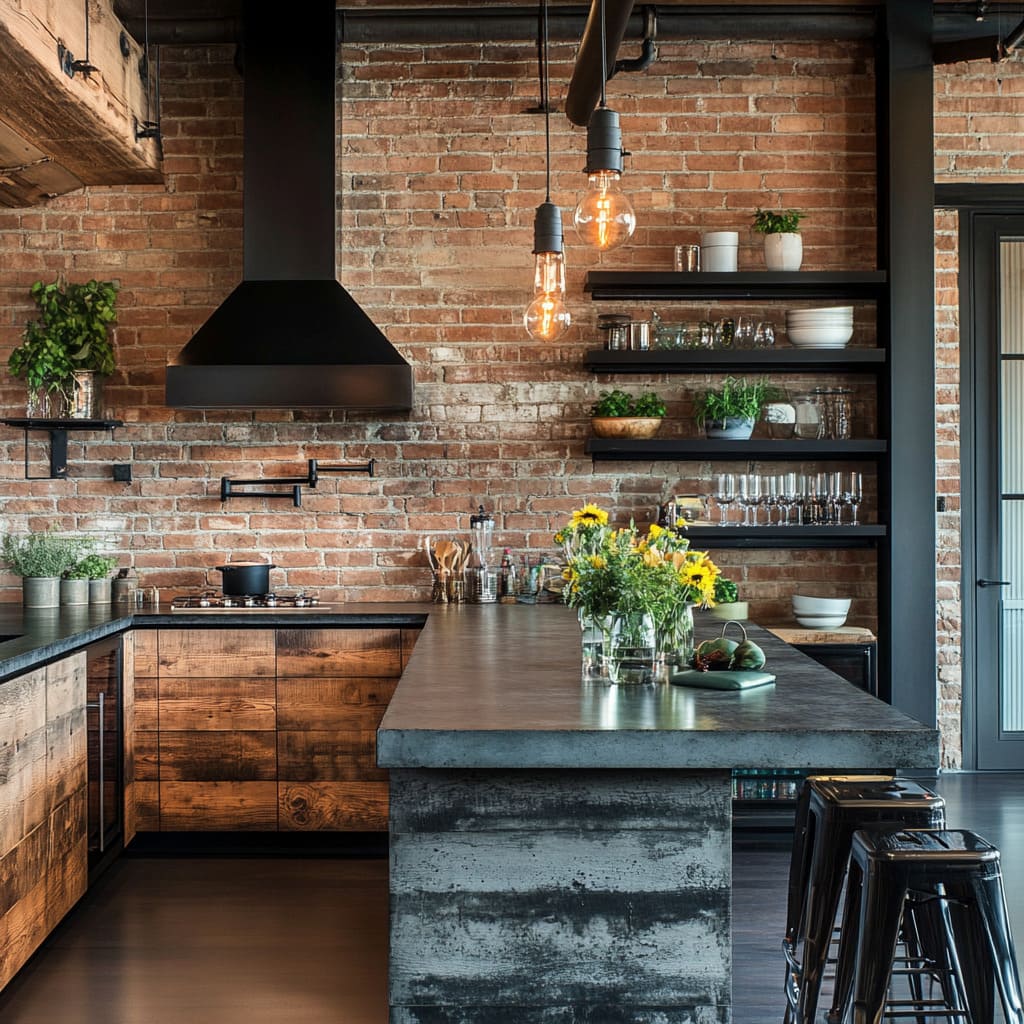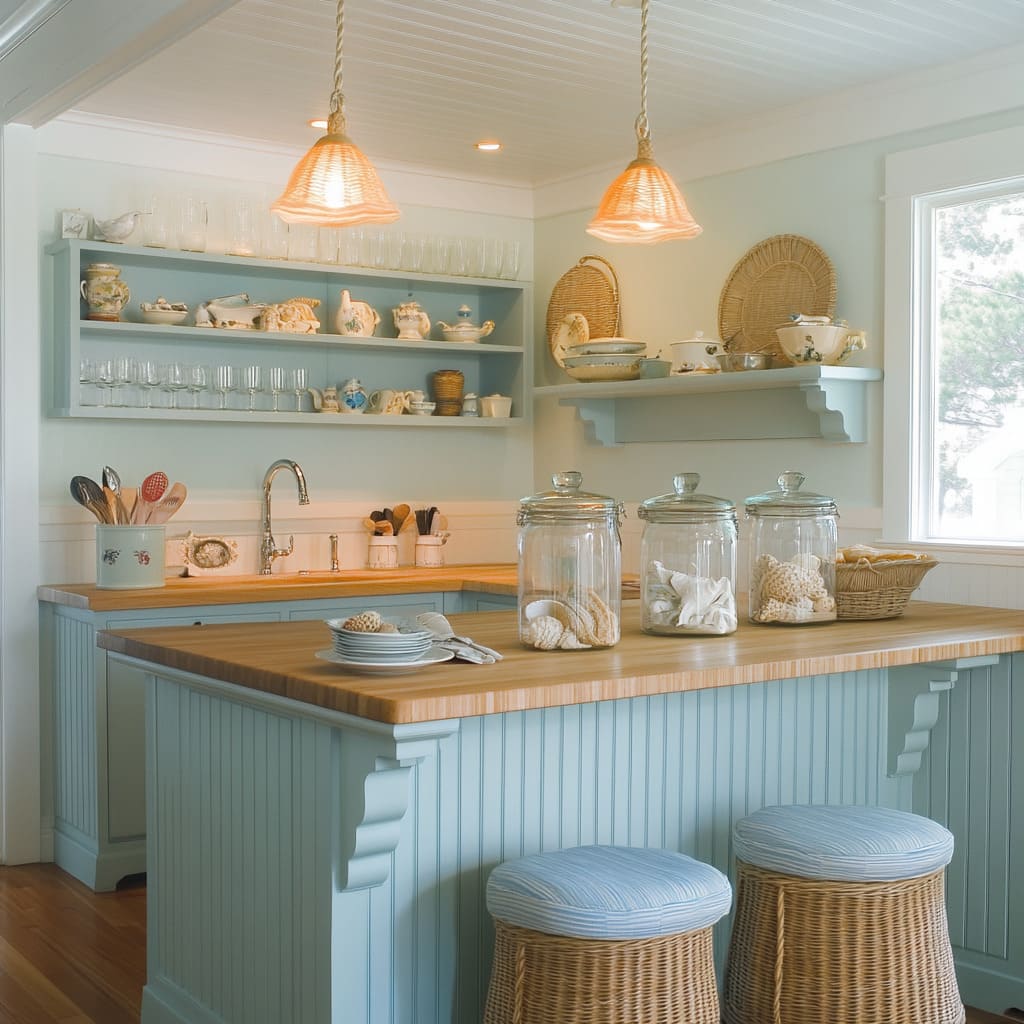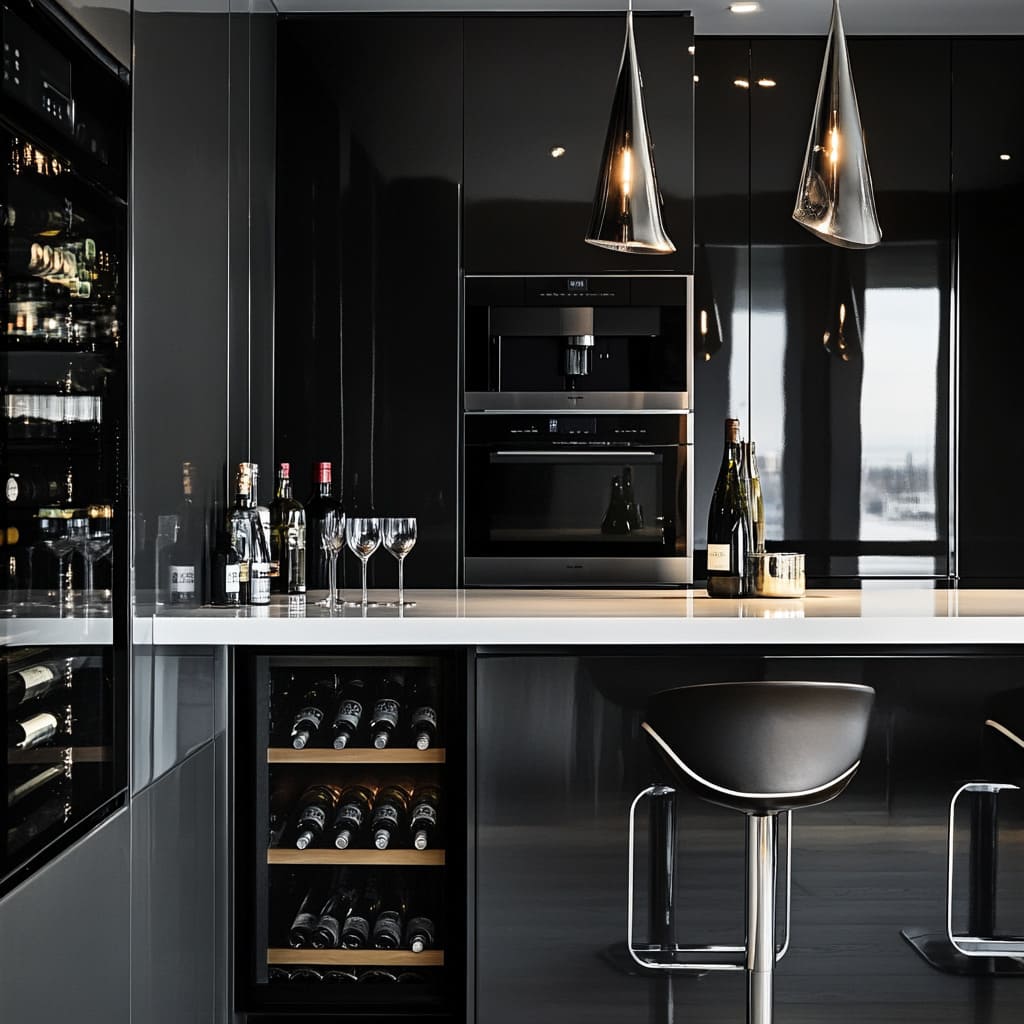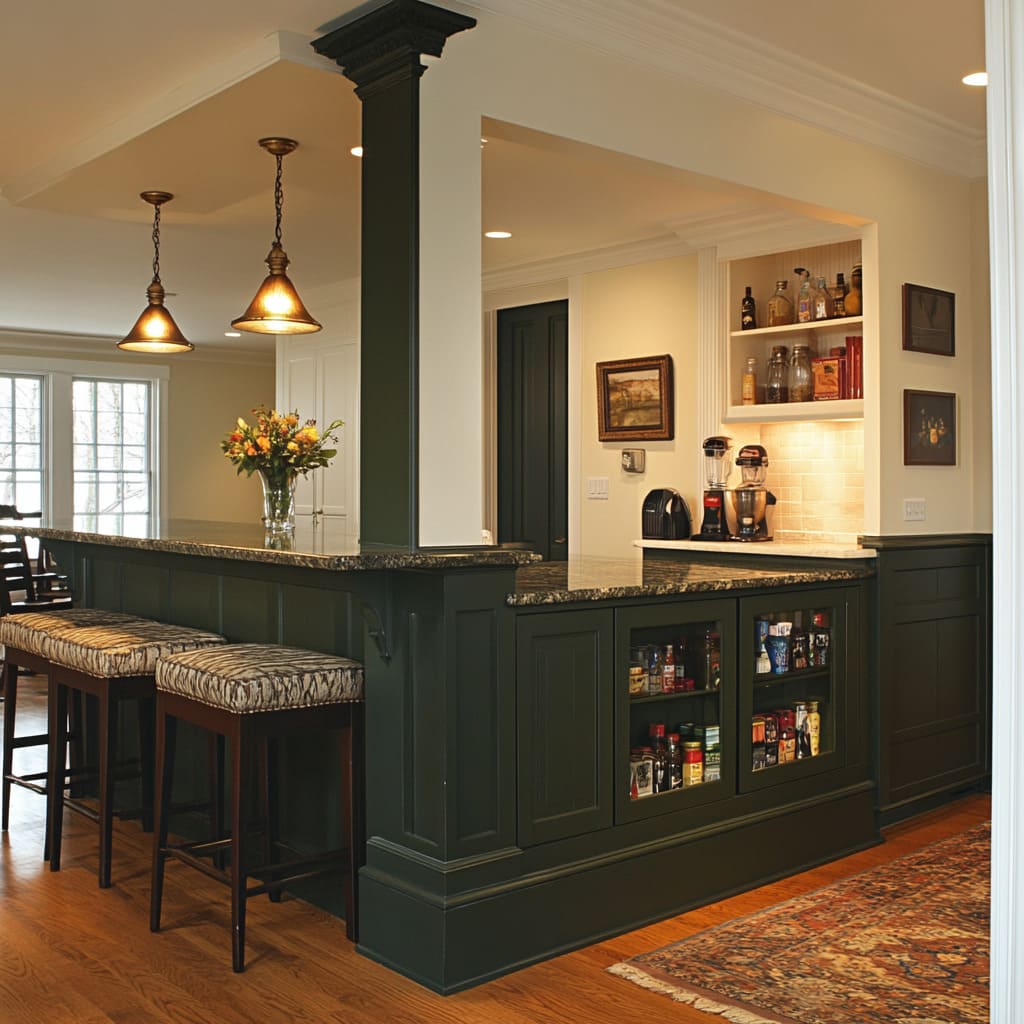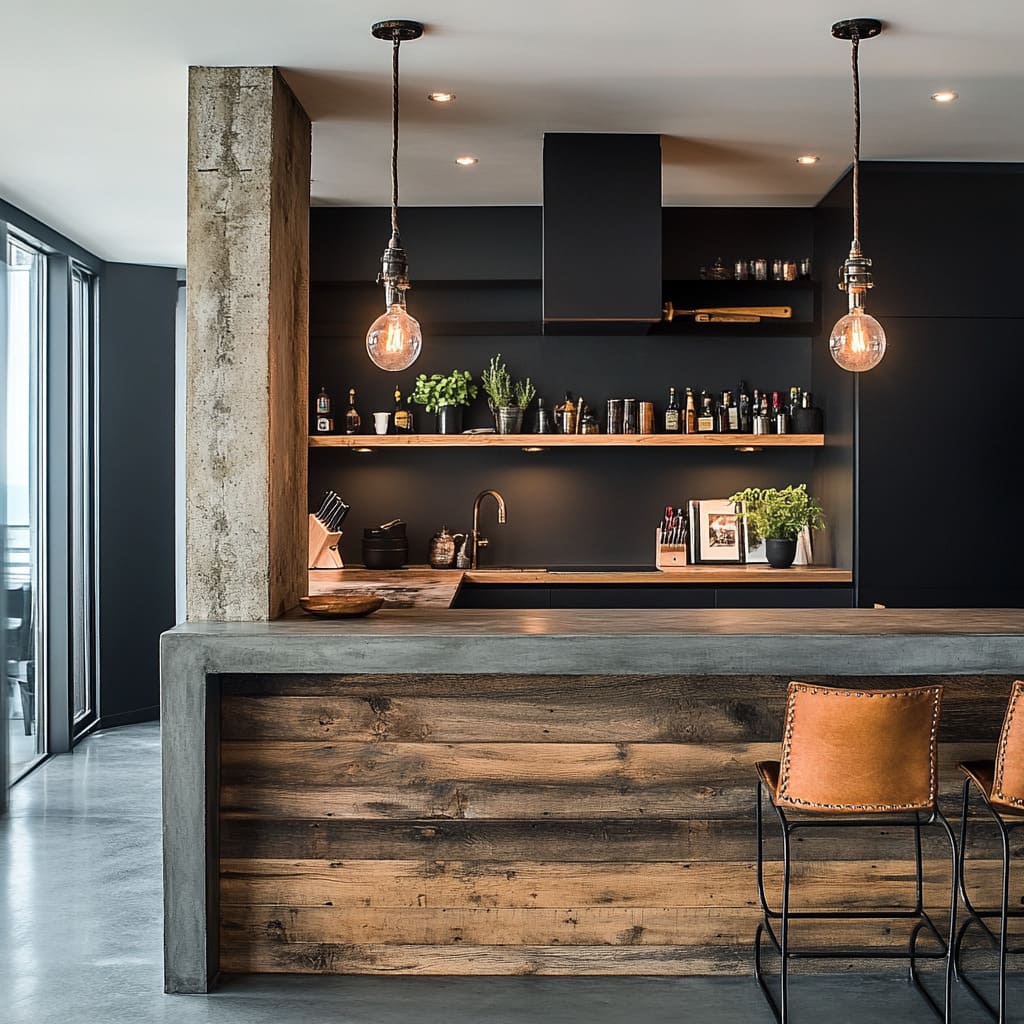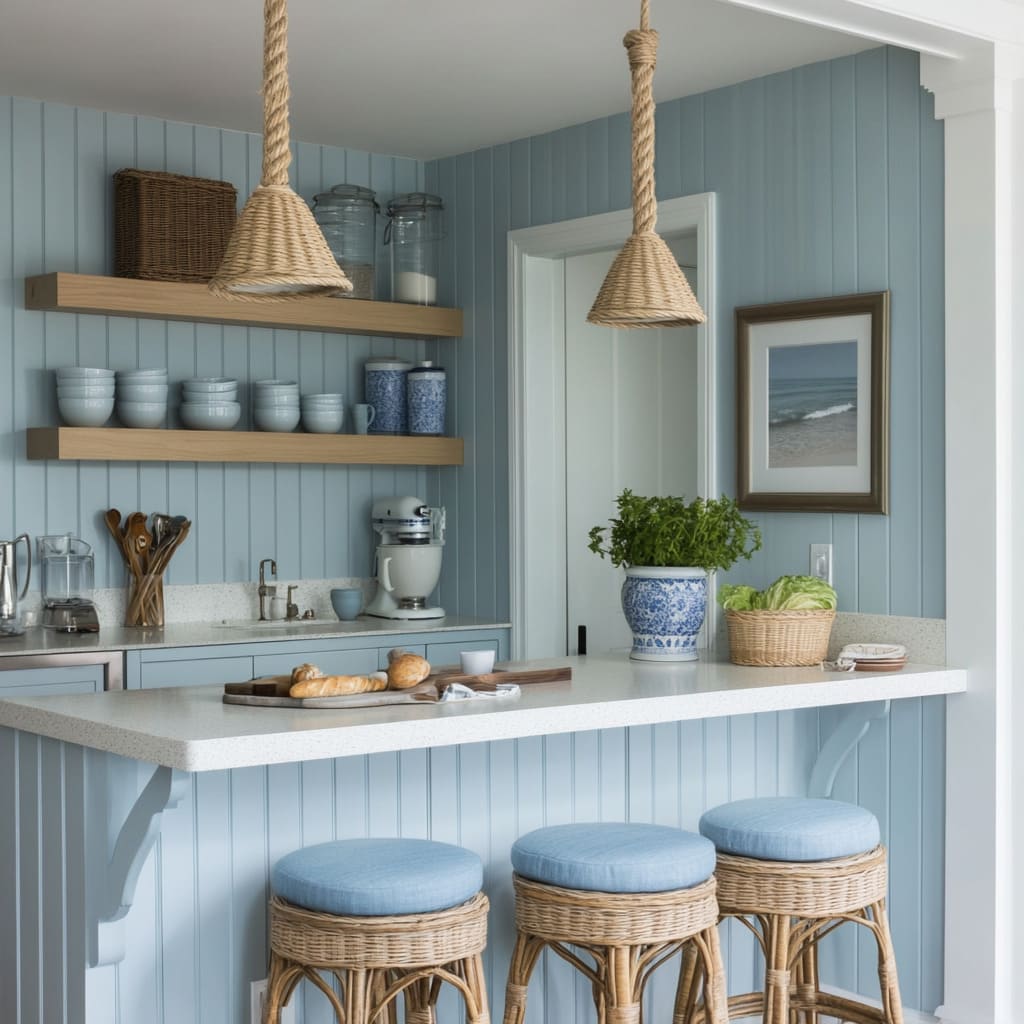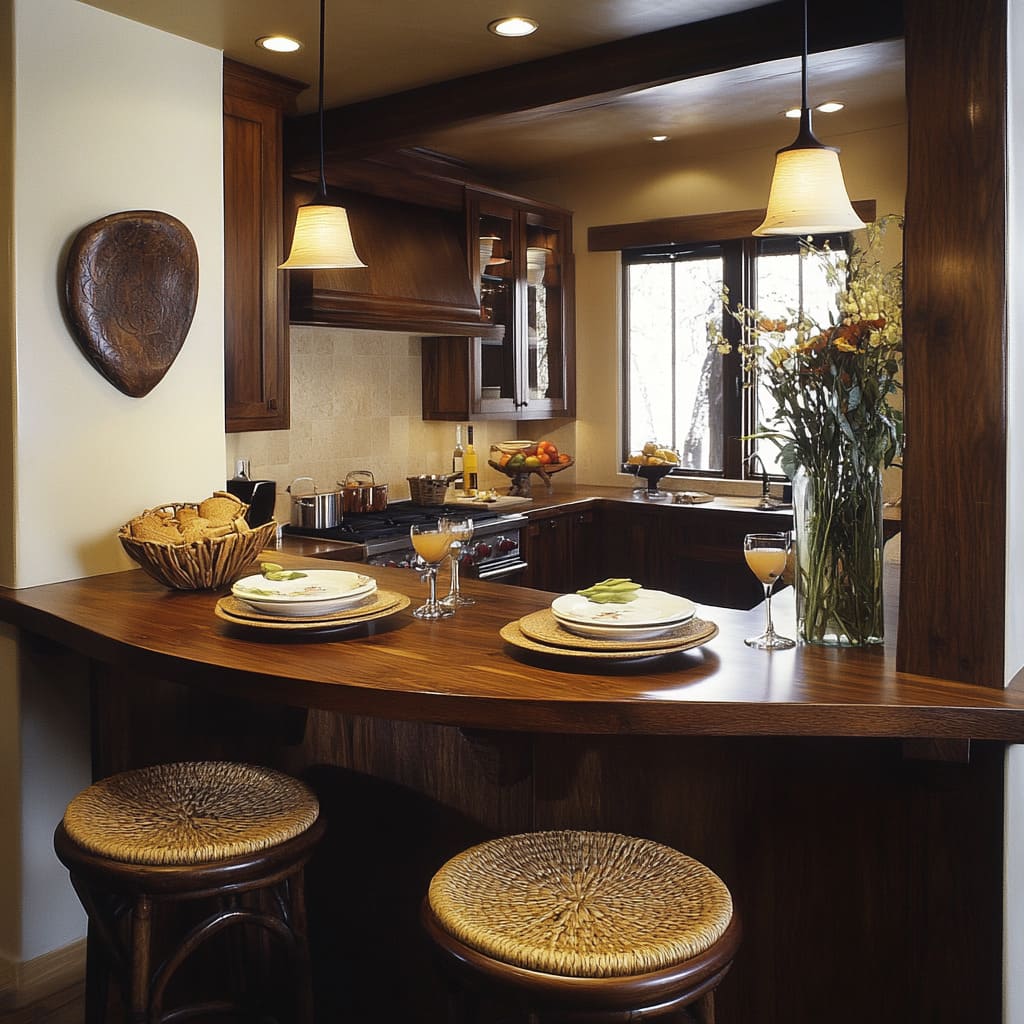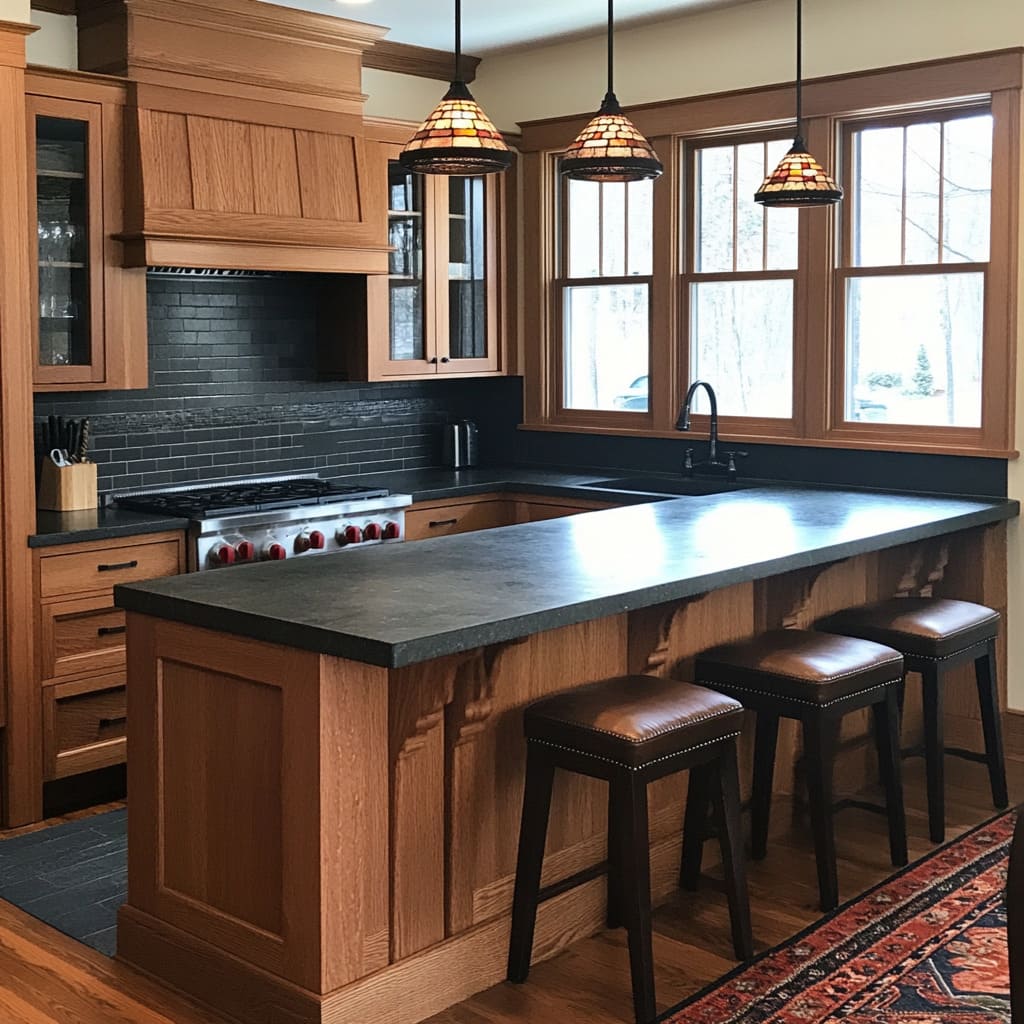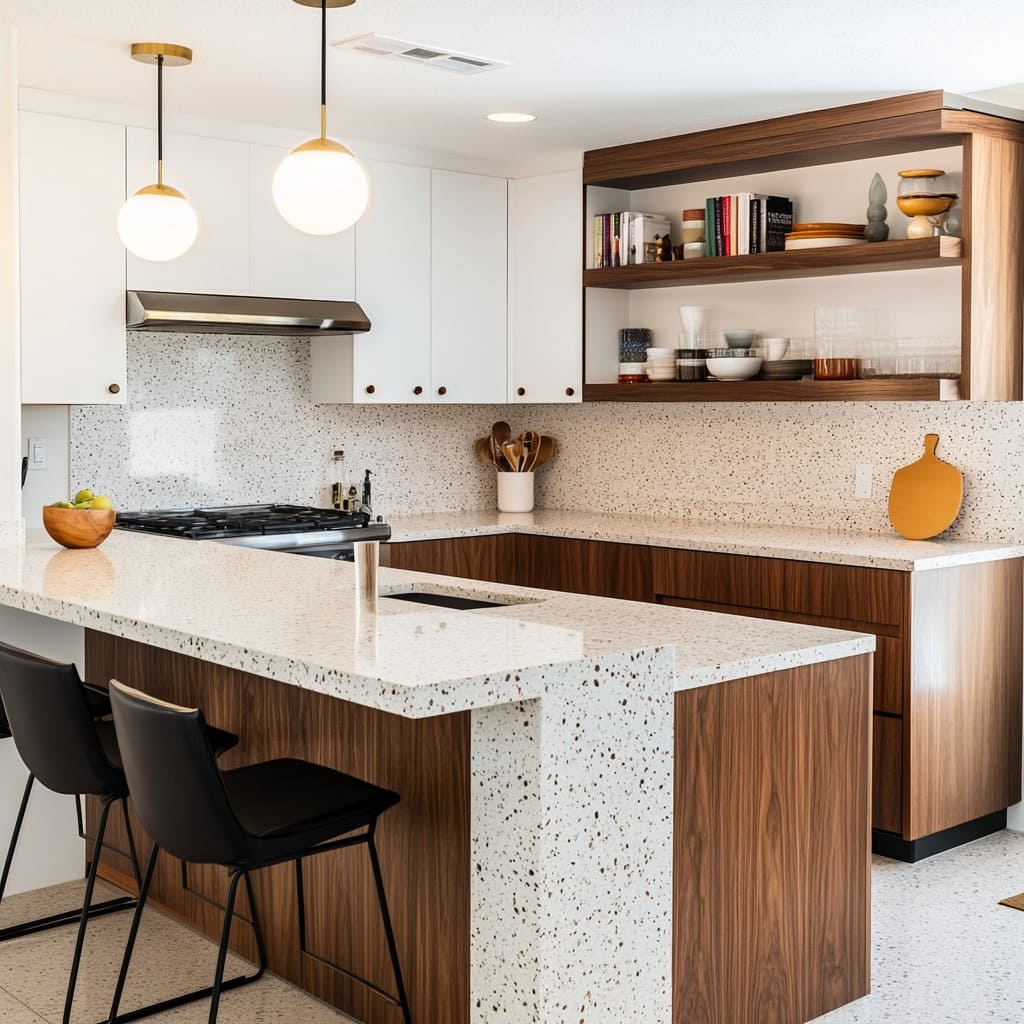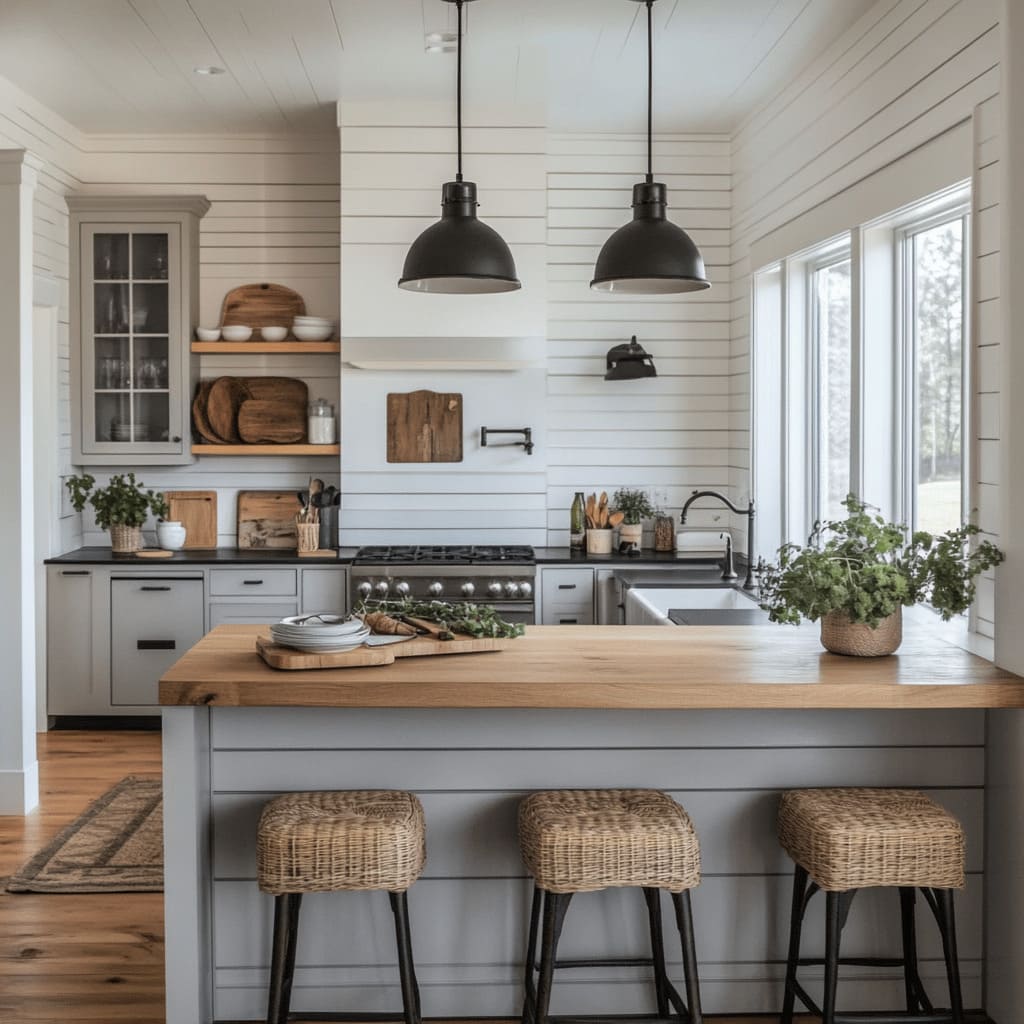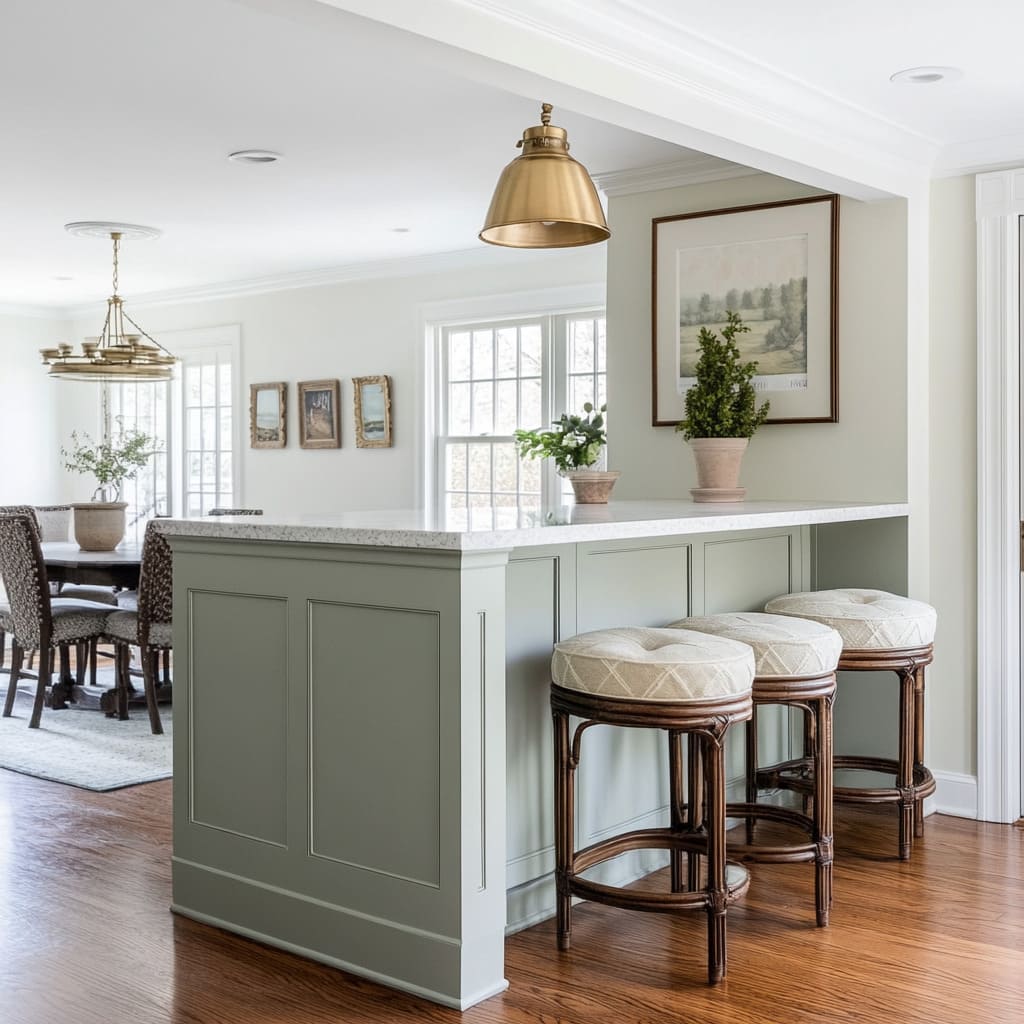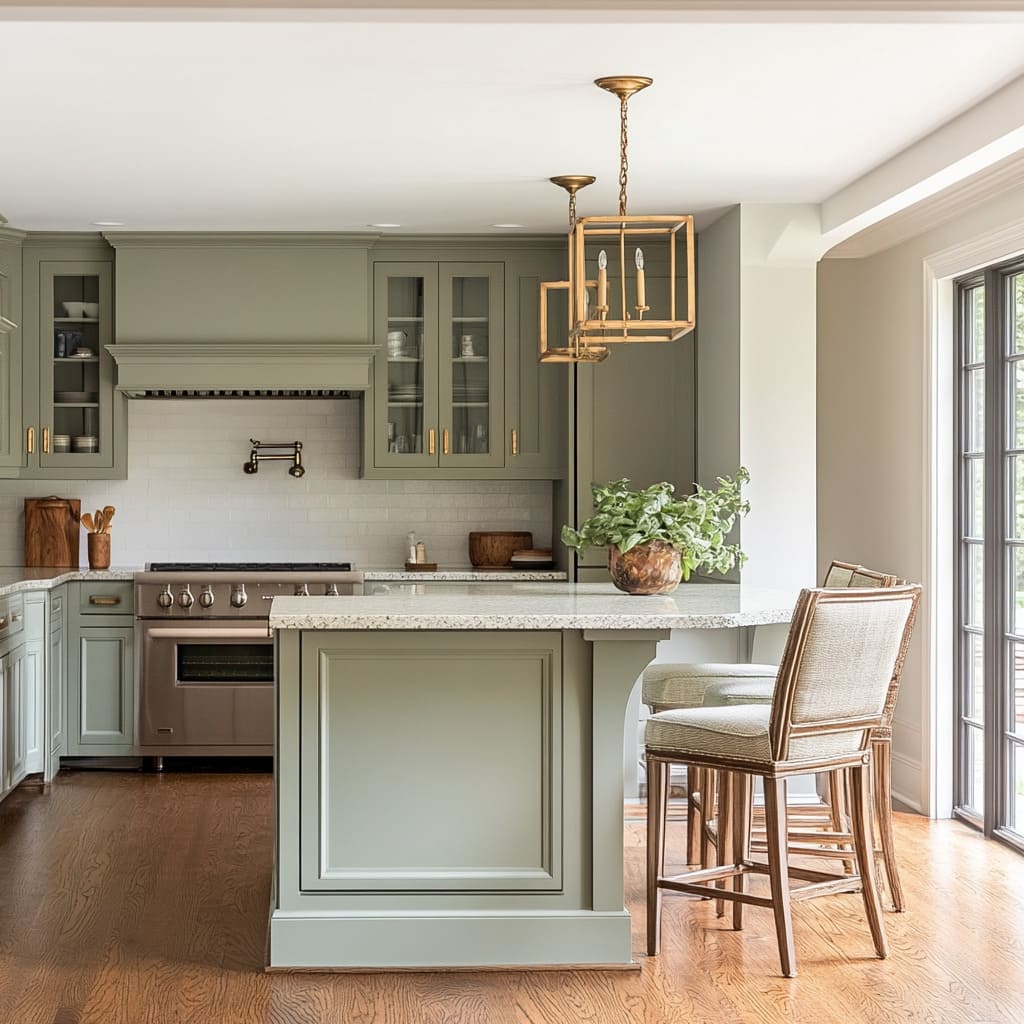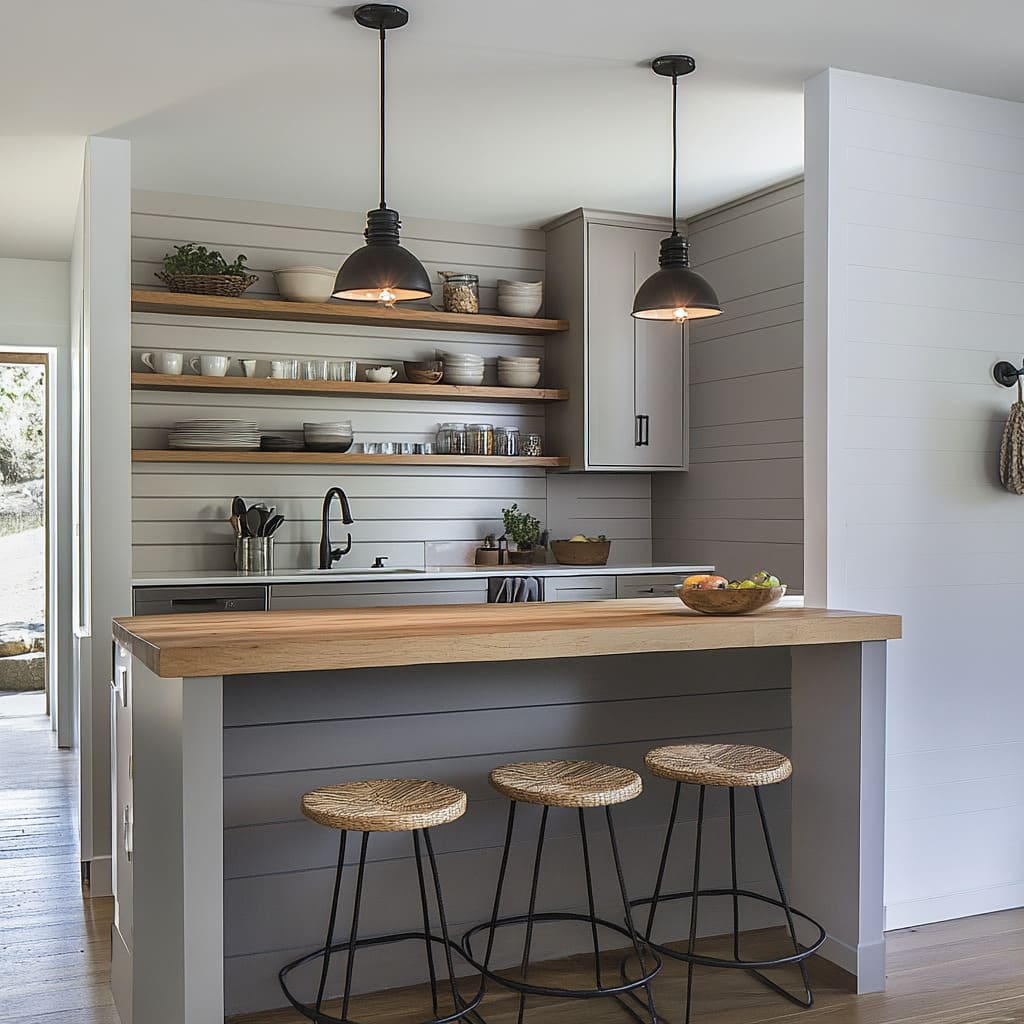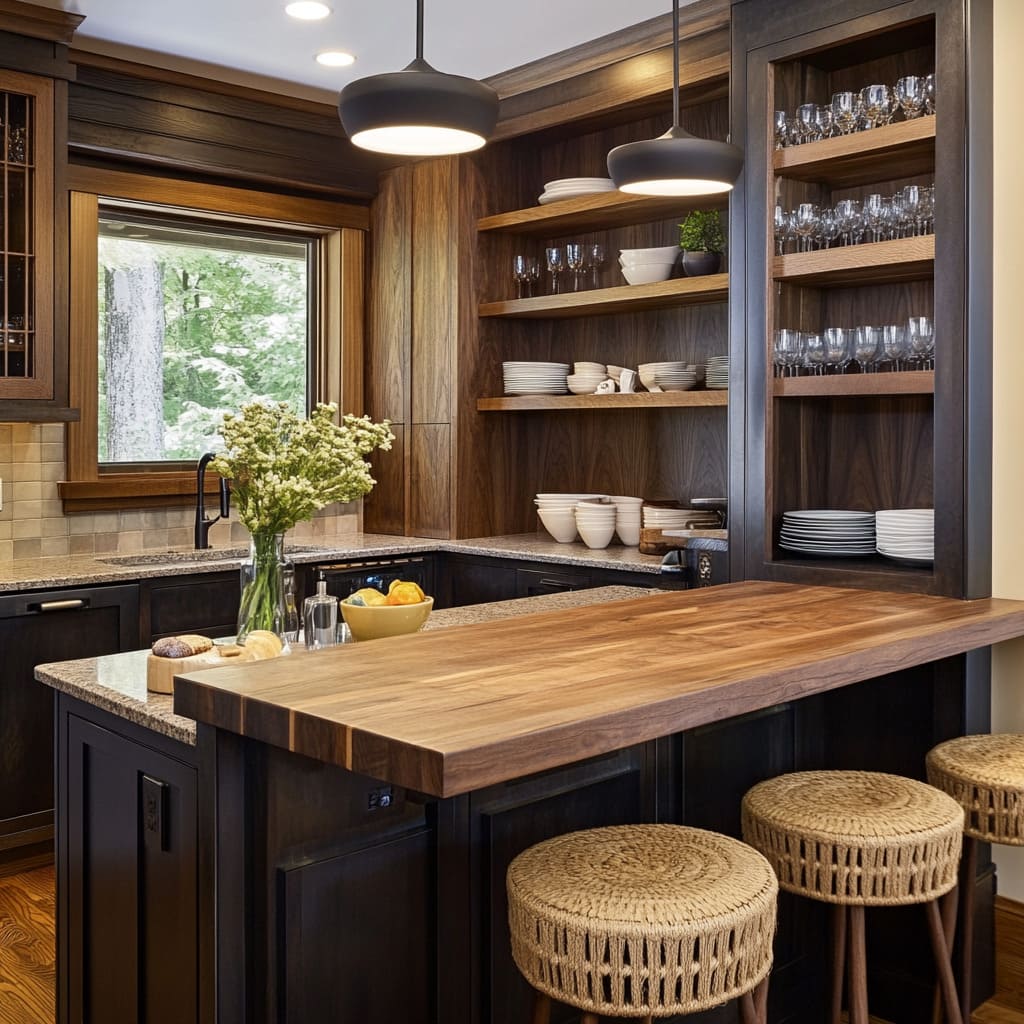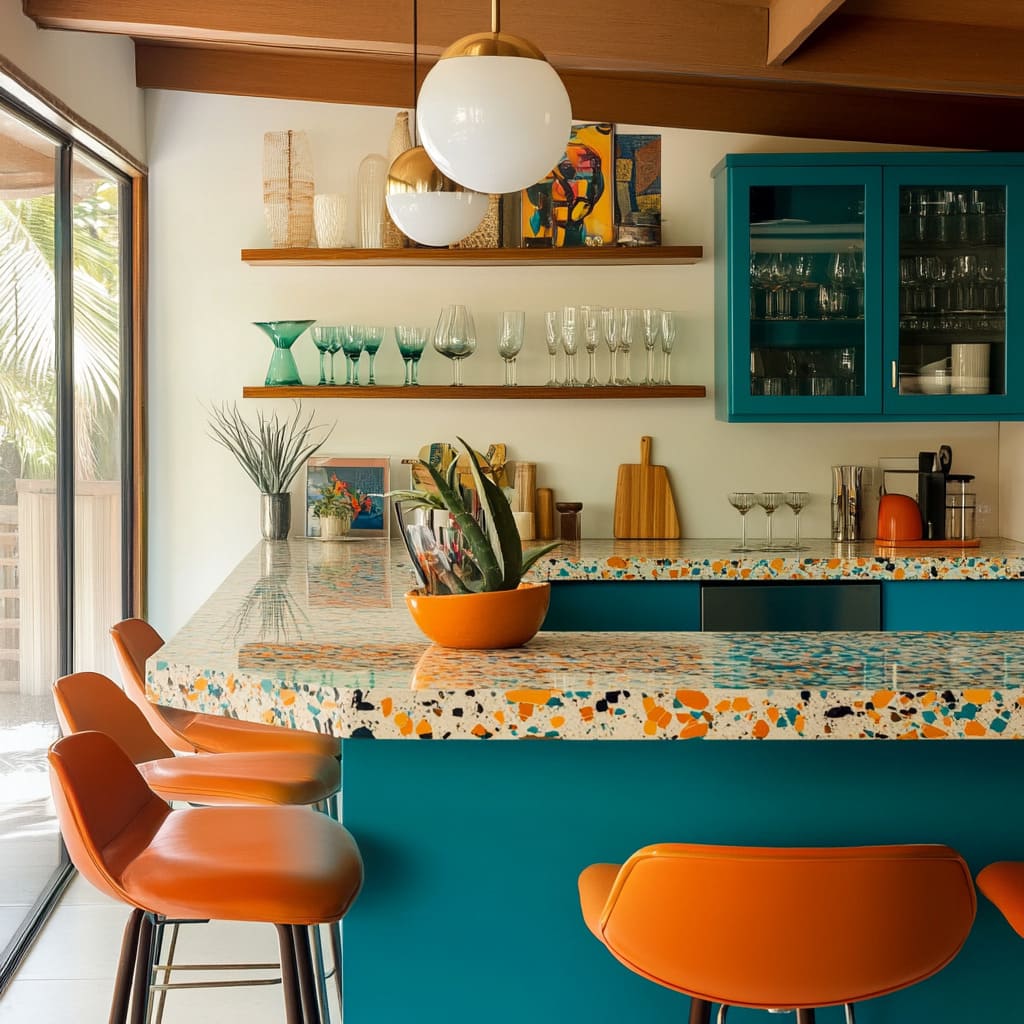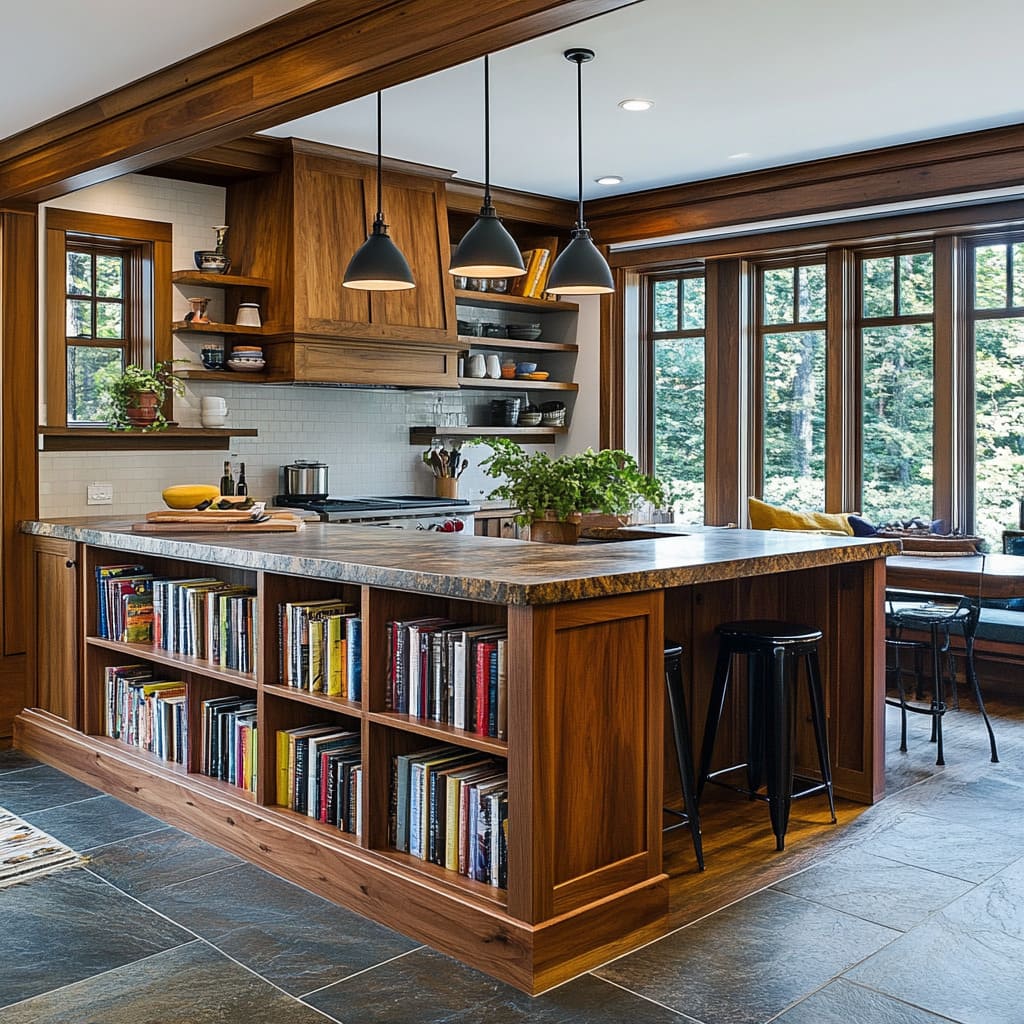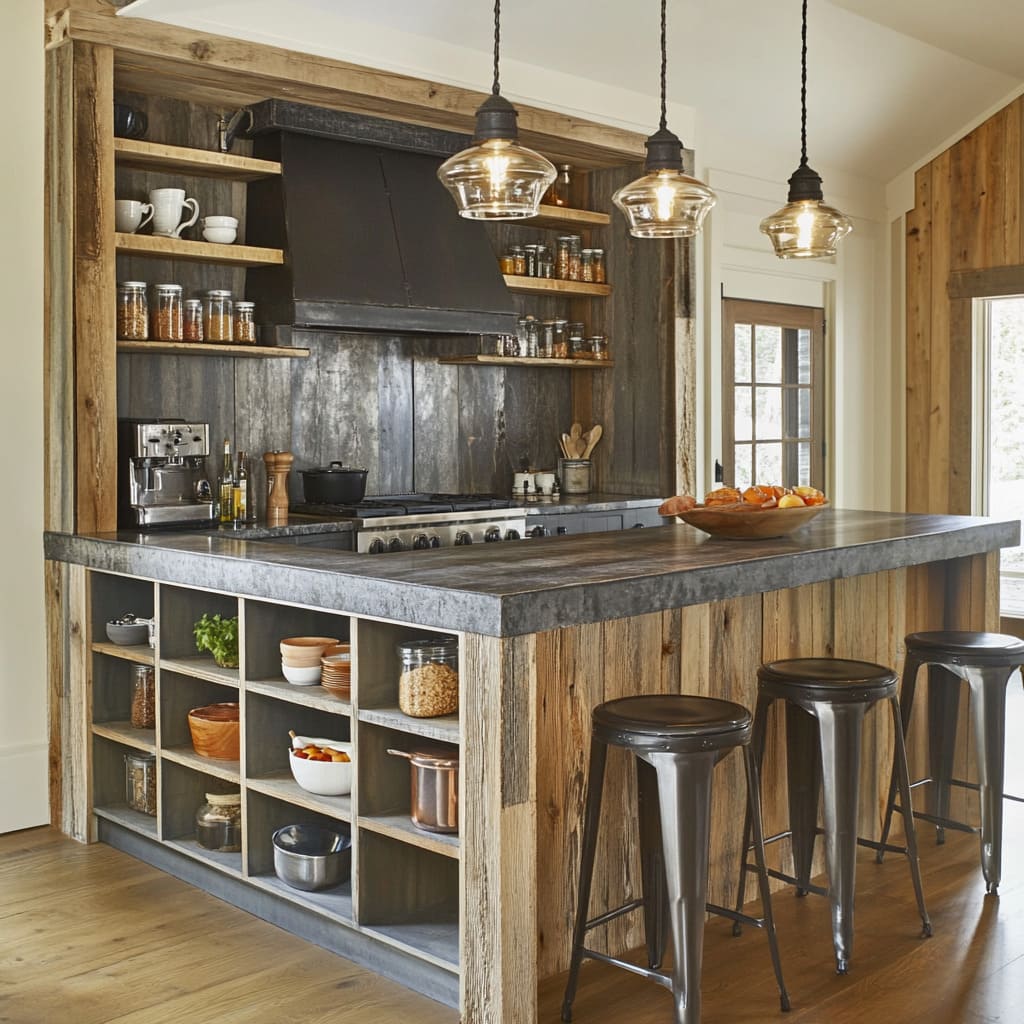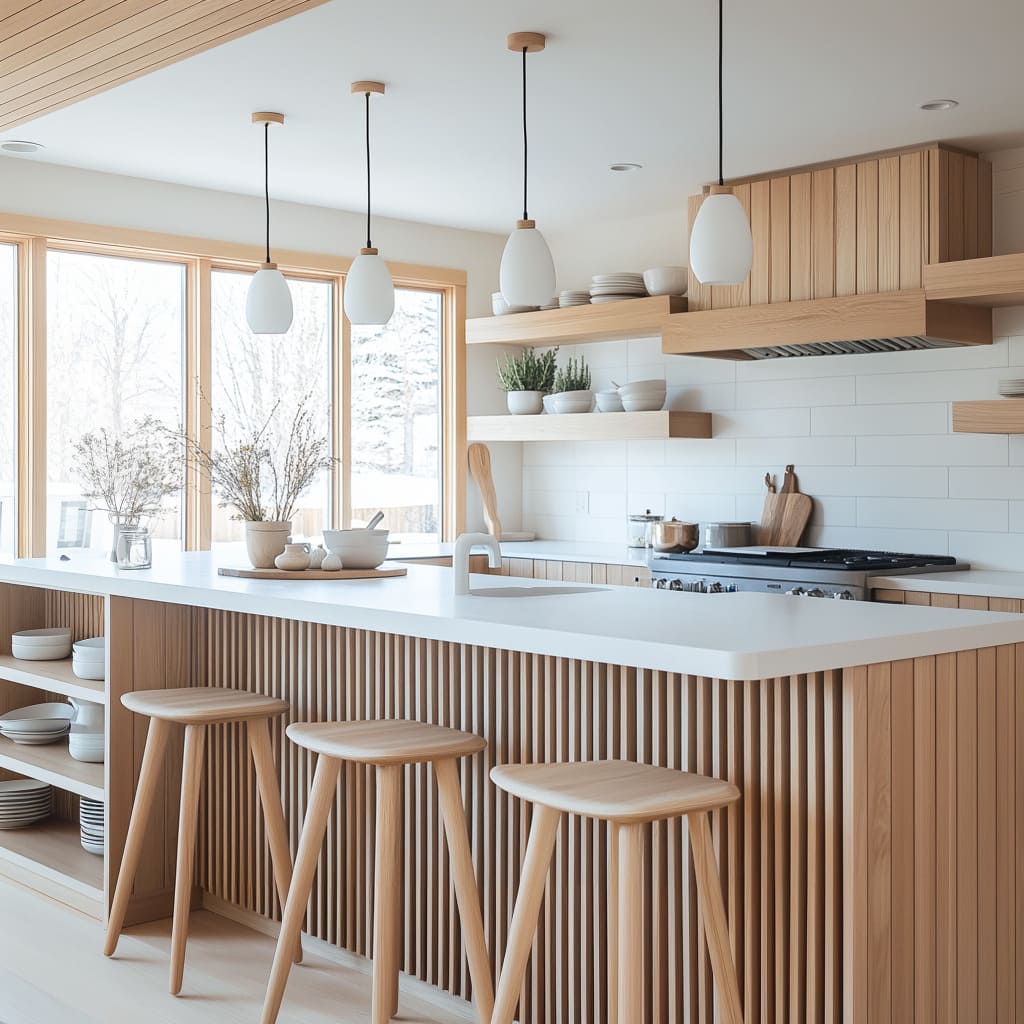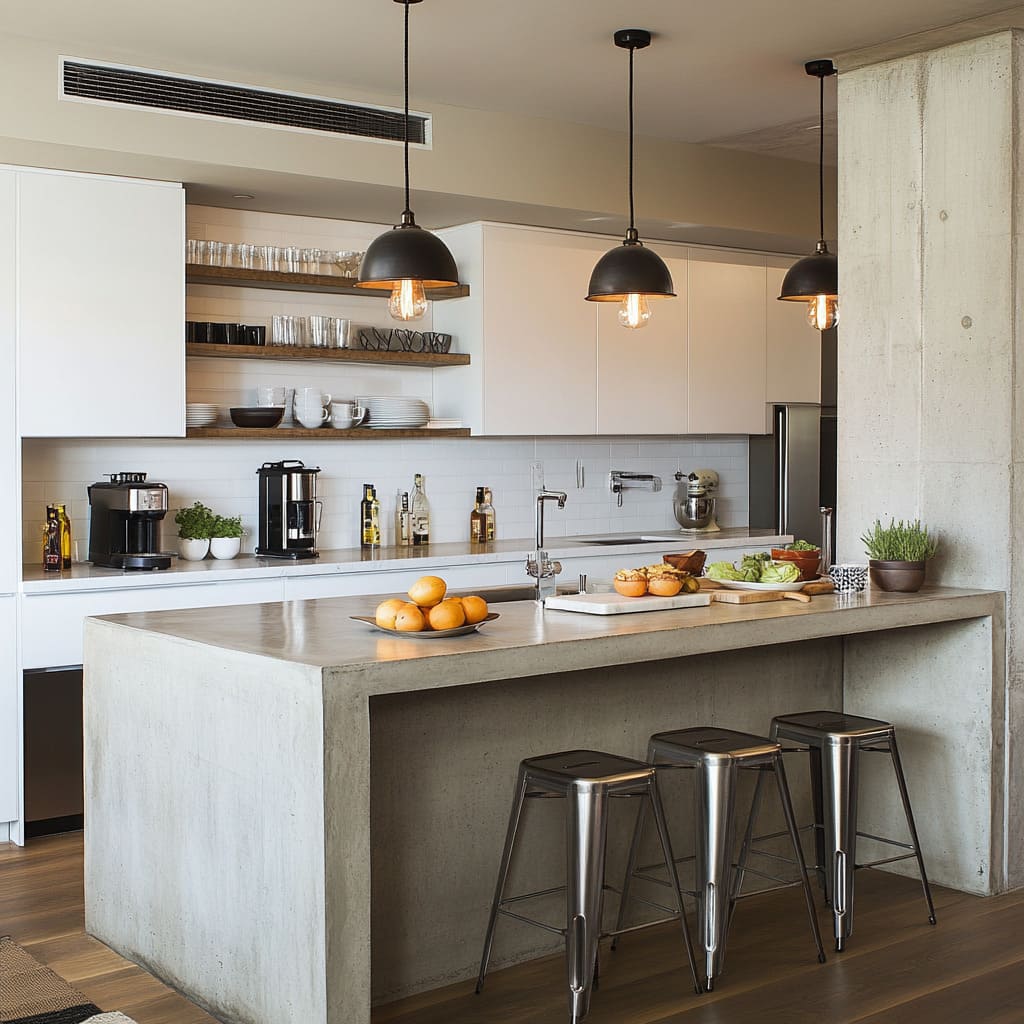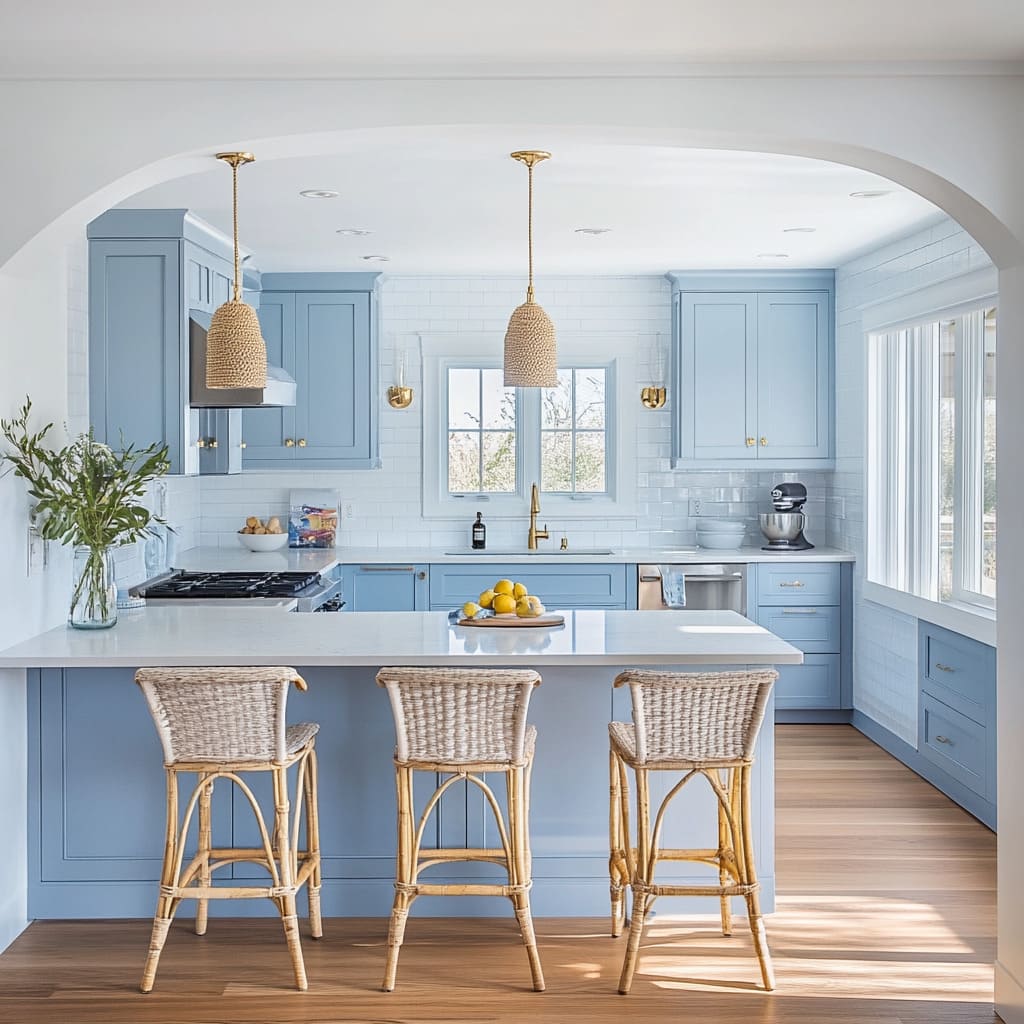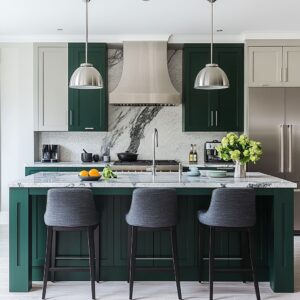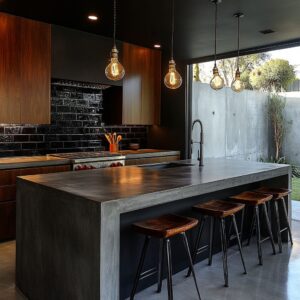Kitchen peninsulas have become a beloved feature in both modern and traditional homes, offering a balance of practicality and design appeal. Whether you’re looking to maximize your kitchen’s functionality or simply want to enhance its aesthetic, a well-designed peninsula can transform the way you use your space.
Unlike islands, which stand alone in the center of the room, peninsulas are anchored on one side, making them versatile additions that can fit into a variety of layouts.
The beauty of kitchen peninsulas lies in their ability to act as a bridge between different zones in the home. For instance, they can help merge the kitchen and living areas in an open-plan layout, creating a unified flow that enhances both cooking and socializing experiences.
In traditional homes, peninsulas serve as a smart divider, subtly separating the cooking space from the dining area without closing off the room entirely. This design approach not only allows for a more connected and interactive home environment but also adds depth and dimension to the kitchen itself.
Throughout this article, we’ll explore a range of kitchen peninsula ideas, showcasing how these versatile elements can suit various styles—from sleek, contemporary designs to warm, rustic themes. We will also look into different configurations and materials to inspire you, whether you’re planning a spacious modern renovation or seeking ideas for a cozy, small kitchen with peninsula features.
Understanding Kitchen Peninsulas
Definition and Purpose
A kitchen peninsula is a countertop extension connected to the rest of the kitchen on one side while projecting out into the room, effectively forming a “peninsula” shape. This design differs from a kitchen island, which is a freestanding structure with no connection to the main cabinetry.
The advantage of a peninsula is that it creates more surface area and storage without requiring as much space as an island, making it particularly well-suited for homes where an island might feel too imposing. The purpose of a peninsula goes beyond merely extending the countertop.
It offers an integrated solution for creating additional workspace, seating, and storage—all while preserving an open, accessible flow in the kitchen. For modern kitchens, a peninsula can act as an informal dining area or a spot for quick meals, while in traditional kitchens, it can be a place to set up for meal preparation or baking.
Peninsulas are especially useful in designs where maximizing space is crucial, and they provide a functional boundary that separates different zones while maintaining an open feel.
Versatility in Design
One of the key strengths of peninsulas is their adaptability, making them a top choice for a wide range of kitchens. Whether you’re working with a large, open-plan space or a smaller, cozier layout, there are countless ways to integrate a peninsula that suits your needs and style.
This flexibility is why kitchen with peninsula ideas remain a popular choice for homeowners and designers alike. In expansive, modern kitchens, peninsulas can serve as a focal point, offering ample room for cooking, socializing, and dining.
They often incorporate features like built-in sinks, stoves, or wine coolers, turning the peninsula into a multifunctional hub that maximizes the kitchen’s capabilities. Such setups are perfect for homes that frequently entertain guests or host family gatherings, allowing the cook to interact while preparing meals.
On the other hand, a small kitchen with peninsula can be an equally effective design solution. In more compact spaces, peninsulas provide much-needed countertop space without the footprint of a traditional island.
They can be configured to include under-counter storage, pull-out drawers, or even open shelving, making them not only space-efficient but also a stylish focal point. By incorporating lightweight bar stools and ensuring the overhang is minimal, these peninsulas can create a casual dining spot that blends perfectly into the kitchen’s flow.
In summary, the versatility of kitchen peninsulas makes them an excellent option for any home, regardless of size or style. With the right design approach, they can become the centerpiece of the kitchen, enhancing both the space’s function and its overall look.
In the following sections, we’ll dive deeper into various styles and configurations, providing a comprehensive guide to the best kitchen peninsula ideas for every type of home.
Peninsula Design Ideas for Modern Kitchens
Modern kitchens thrive on simplicity, clean lines, and functionality. The kitchen peninsula, in this context, is not just an extension of the countertop but a versatile, integral part of the kitchen layout that defines the flow and atmosphere of the space.
Let’s explore a few standout peninsula designs tailored for modern kitchens, showcasing how these features can transform and elevate your cooking and dining experience.
Minimalist and Sleek Peninsulas
Minimalist kitchens are all about understated elegance. A minimalist kitchen peninsula focuses on crisp, clean lines and refined finishes.
The structure often features streamlined cabinetry that blends seamlessly with the rest of the kitchen. Materials like polished concrete or quartz are popular choices for countertops, giving the space a sleek and refined look while maintaining durability and ease of maintenance.
The color palette plays a crucial role in this style, with neutral tones such as white, gray, and black dominating the scene. These shades align with the minimalist aesthetic, creating a sense of openness and calm, which is particularly effective in urban settings where space may be at a premium.
Example: Imagine an urban loft kitchen with a concrete peninsula at its heart. The peninsula, with its smooth surface, complements industrial lighting fixtures that hang above, casting warm pools of light onto the countertop.
The concrete’s texture pairs with exposed brick and metal accents, balancing the raw and refined elements that define modern industrial kitchens. This setup exemplifies how the peninsula acts as a focal point, merging form and function effortlessly.
Scandinavian-Inspired Peninsulas
Scandinavian design emphasizes simplicity, natural light, and functional use of space. In this style, kitchen peninsulas are crafted using natural materials like light oak wood, which brings warmth and a touch of nature into the kitchen.
The choice of wood for both the cabinetry and the countertop enhances a bright and airy feel, essential for creating the open, welcoming spaces characteristic of Scandinavian kitchens. Scandinavian-inspired peninsulas often incorporate open shelving, allowing for easy access to everyday items while maintaining a clean and organized look.
The focus on efficiency ensures that every part of the peninsula serves a practical purpose, whether as additional prep space or as an informal dining area.
Example: Picture a Scandinavian kitchen where light wood slats line the front of the peninsula, creating a sense of depth and texture. A white quartz countertop rests atop, reflecting natural light that pours in through large windows.
The integration of light, neutral tones keeps the space feeling expansive and open, while the functionality of open shelving ensures that the kitchen remains practical without sacrificing its harmonious, calming appeal.
Mid-Century Modern Peninsulas
For those who love a retro touch, mid-century modern kitchens offer a unique and playful approach to design. Kitchen peninsulas in this style often feature bold colors, terrazzo countertops, and curved edges, all hallmarks of the mid-century look.
The aim is to create a dynamic yet cohesive feel, where the kitchen becomes not just a place for cooking but a vibrant social hub. Mid-century peninsulas frequently use wood detailing to warm up the space, while terrazzo countertops bring in a splash of color and visual interest.
The integration of rounded forms and bright hues can help break up the linear nature of typical kitchen spaces, making them more inviting and lively.
Example: Envision a mid-century kitchen where the peninsula boasts a colorful terrazzo countertop, speckled with blues, yellows, and whites that echo the playful vibe of the 1950s and 60s. Warm wood cabinetry frames the countertop, tying into other elements like the shelving and built-in storage, creating a cohesive look that feels both nostalgic and modern.
The curved design of the peninsula flows effortlessly into the surrounding layout, enhancing the kitchen’s role as a lively gathering spot.
Industrial Loft Peninsulas
Industrial kitchens embrace raw materials and utilitarian features, and the peninsula design in such spaces often reflects this ethos. Concrete countertops, metal accents, and industrial lighting fixtures are key components, lending the space an edgy yet functional aesthetic.
The rough texture of concrete or raw wood is balanced by the clean, sleek lines of metal bar stools and black cabinetry, creating a blend of rugged and contemporary elements. An industrial kitchen peninsula not only provides a practical work area but also serves as a visual statement that defines the style of the kitchen.
These designs typically suit open-plan kitchens where the peninsula acts as a divider, separating the cooking area from the living or dining space while still maintaining a sense of openness and connection.
Example: Consider a loft kitchen where the peninsula is crafted from exposed concrete, creating a bold centerpiece. The raw finish of the concrete pairs with black metal bar stools and pendant lights that feature Edison bulbs, giving the space a warm, inviting glow.
The combination of materials strikes a perfect balance, merging the utilitarian feel of the industrial style with the smooth, modern finishes that make the space functional and visually cohesive. This setup works particularly well in a galley kitchen with peninsula, allowing for maximum efficiency while maintaining a strong visual identity.
The versatility of kitchen peninsulas in modern designs allows for endless creativity, whether you lean towards minimalist, Scandinavian, mid-century, or industrial styles. By carefully selecting materials and finishes, you can create a peninsula that not only enhances the function of your kitchen but also serves as a visual anchor that defines its overall character.
From sleek, polished concrete to playful terrazzo or natural light oak, the possibilities are vast, ensuring there’s a perfect design for every modern home. In the next section, we’ll explore how these concepts translate into traditional and transitional kitchens, showing how peninsulas can be adapted to suit various aesthetics while maintaining their essential functionality.
Whether you’re considering kitchen ideas with peninsula features or planning small kitchen layouts with peninsula options, there’s an approach that fits every style and space.
Peninsula Ideas for Traditional and Transitional Kitchens
Traditional and transitional kitchens thrive on character and warmth, making peninsulas an ideal feature to enhance these classic designs. Whether your style leans towards the rustic charm of farmhouse aesthetics or the polished elegance of a timeless setup, a peninsula can tie everything together, adding function and a sense of cohesion.
This section explores various peninsula kitchen design ideas, tailored for traditional and transitional styles, to help create a kitchen that feels both inviting and practical.
Farmhouse and Rustic Peninsulas
Farmhouse kitchens are all about warmth and comfort, and a well-crafted peninsula can be the heart of this setting. The focus is on natural, rustic materials and features that create a welcoming atmosphere.
- Material Selection: The use of butcher block countertops is a quintessential choice for farmhouse peninsulas. Butcher block surfaces not only add a cozy, tactile element but also provide a durable and functional workspace for food preparation. To complement this, shiplap paneling is often incorporated on the front or sides of the peninsula, adding texture and that signature farmhouse feel. Warm wood finishes, such as oak or pine, enhance the overall look, grounding the kitchen in a natural, earthy aesthetic.
- Rustic Details: To amplify the charm, incorporating open shelving is an excellent option. These shelves can be used to display rustic ceramics, vintage glassware, or copper cookware, giving the kitchen a lived-in, authentic appearance. Wooden beams or decorative corbels along the peninsula add an extra layer of detail, making the space feel both crafted and personal.
Example: Imagine a farmhouse kitchen with a shiplap-paneled peninsula topped with a butcher block surface. Open wood shelving runs along the side, holding neatly arranged ceramics and wooden serving boards, while vintage brass hooks provide a spot for hanging towels.
This setup not only offers functional storage but also adds visual appeal, creating a warm and inviting space that feels like the perfect place to gather and cook.
Coastal and Cottage-Style Peninsulas
For those who love a light and breezy aesthetic, coastal and cottage-style kitchens offer a delightful way to integrate a peninsula. The emphasis here is on creating an airy, relaxed atmosphere with soft, natural hues and lightweight materials.
- Light and Airy Aesthetics: A coastal peninsula often uses soft colors like pale blues, whites, or muted seafoam greens, paired with natural wood tones. These shades reflect light, making the space feel open and calm. The addition of beadboard paneling on the peninsula brings a classic, coastal texture that pairs beautifully with these color schemes.
- Design Details: Wicker bar stools are a perfect match for coastal kitchens, providing casual, laid-back seating that fits the beachy vibe. Pendant lighting, particularly those with woven or rattan shades, adds to the relaxed atmosphere while ensuring the space remains functional for both cooking and socializing. Small details like these come together to create a cohesive, beach-inspired look that feels fresh and open.
Example: Picture a coastal kitchen where a beadboard peninsula painted in a soft blue hue serves as the focal point. Wicker stools line the counter, offering a casual seating area that’s perfect for morning coffee or an afternoon snack.
Overhead, woven pendant lights cast a warm, diffused glow, enhancing the open and welcoming vibe typical of cottage design. The use of light wood accents and sea-inspired colors ensures the space remains bright and airy, echoing the feel of a coastal retreat.
Traditional Elegance
For those who favor a timeless, sophisticated kitchen, a traditionally designed peninsula can bring both style and functionality. These designs often feature classic materials and finishes that align with the refined look of a traditional kitchen, creating an elegant and cohesive space.
- Classic Materials: Granite or marble countertops are popular choices for traditional peninsulas, adding a luxurious touch that pairs beautifully with painted wood cabinetry. These materials provide durability and style, ensuring the peninsula remains a standout feature while blending harmoniously with the rest of the kitchen. Cabinetry can be painted in neutral shades like cream, white, or deep forest green, keeping the look classic and enduring.
- Functional Elements: Built-in storage is key in traditional kitchens, and the peninsula offers a perfect opportunity for adding drawers, cabinets, or even wine racks that match the kitchen’s overall aesthetic. Detailed cabinetry, such as paneled doors or decorative molding, reinforces the sense of elegance, ensuring the peninsula feels like a natural extension of the space. Pairing these details with classic pendant lighting, such as glass or metal fixtures, completes the look, bringing both function and sophistication to the kitchen.
Example: Visualize a traditional kitchen featuring a granite-topped peninsula framed by detailed cabinetry painted in a rich, timeless shade. Above, classic pendant lights with frosted glass shades cast a soft glow, emphasizing the luxurious feel of the space.
The peninsula offers built-in storage solutions, including drawers for utensils and shelves for cookbooks, ensuring the kitchen remains organized and efficient. This setup reflects a refined aesthetic, showcasing how a peninsula can serve as both a functional and decorative focal point.
The variety of peninsula kitchen island ideas available for traditional and transitional styles demonstrates their versatility and charm. Whether you prefer the cozy feel of a farmhouse kitchen or the sophistication of a traditional setup, peninsulas can adapt to enhance the overall aesthetic.
From shiplap paneling to marble countertops, the right choice of materials and design elements ensures your peninsula integrates seamlessly, adding warmth, practicality, and style. In smaller spaces, such as a narrow kitchen with peninsula features, these designs can also be scaled down to fit the room’s dimensions while maintaining the same level of impact.
With thoughtful planning, a peninsula can transform your kitchen, making it the heart of your home, whether you aim for a relaxed coastal feel or a timeless, traditional look.
Key Features and Functional Elements in Peninsula Design
Kitchen peninsulas are more than just extensions of countertop space; they are multifunctional elements that bring practicality and style into the heart of the home. By understanding how to maximize their design potential, you can turn a simple peninsula into a central feature that serves multiple needs—from storage and seating to lighting and connectivity.
Let’s explore the essential features that enhance the functionality and aesthetic value of kitchen peninsulas, ensuring they become standout components in any kitchen layout.
Storage Solutions
One of the greatest advantages of a kitchen peninsula is its ability to provide extra storage in an efficient and stylish manner. The options are diverse, allowing for customization based on your kitchen’s style and needs:
- Built-in Cabinets: Cabinets beneath the countertop are a common and practical choice. These can be designed to match the rest of the kitchen’s cabinetry, maintaining a unified appearance. Whether you opt for traditional paneled doors or sleek, handleless units, the key is to make them blend seamlessly with the peninsula’s design.
- Open Shelving: For a more open look, consider incorporating shelving instead of closed cabinets. Open shelves are ideal for displaying everyday items like plates and glasses, making them easily accessible while also adding visual interest. This option works particularly well in kitchens with a rustic or coastal vibe, where a more casual, laid-back feel is desired.
- Wine Racks and Specialty Storage: Peninsulas can also house built-in wine racks or other specialty storage options, such as spaces for cookbooks or spice collections. These additions not only make the most of the available space but also add a personalized touch that reflects the homeowner’s lifestyle.
Examples of Hidden Storage Solutions: Hidden storage is another smart approach, especially for those who prefer a clean and uncluttered look. Pull-out drawers disguised as panels, built-in compartments for small kitchen appliances, or even a pull-out trash bin can be cleverly incorporated.
These designs keep the kitchen organized and functional without disrupting the visual flow of the space, making it easier to maintain a tidy, polished look.
Integrated Seating Areas
Creating a seating area at the peninsula is one of the most popular and functional design choices. This addition transforms the peninsula into a social hub, making it more than just a workspace.
The use of overhangs on the countertop provides ample space for bar stools, encouraging casual dining, chatting, or even working from the kitchen.
- Designing Overhangs: An overhang of 12 to 18 inches typically works best for comfortable seating arrangements. This extension allows for bar stools to be tucked under the counter when not in use, saving space and keeping the area neat. The size of the overhang should be proportional to the kitchen’s dimensions, ensuring it enhances rather than crowds the space.
- Choosing the Right Bar Stools: The selection of stools can significantly influence the overall look of the kitchen. For a modern kitchen, metal stools with clean lines and minimal detailing are an ideal match, complementing a sleek, contemporary aesthetic. In contrast, wooden stools with woven seats work well in coastal or farmhouse-style kitchens, adding warmth and texture. For a more eclectic or mid-century approach, colorful or vintage stools can create a playful contrast that brings personality to the space. Integrating seating into a peninsula design can also help connect different parts of the home.
For instance, a kitchen peninsula into dining room configuration allows the peninsula to act as a bridge, connecting the kitchen to the dining area seamlessly. This setup not only maximizes the use of space but also creates a dynamic and interactive environment where cooking, dining, and socializing naturally blend together.
Lighting Choices
Lighting plays a crucial role in defining the atmosphere of a kitchen peninsula. The right lighting setup can elevate the functionality and style of the space, making it both practical for cooking and inviting for dining or entertaining.
Pendant lights are particularly effective for peninsulas, as they provide focused illumination while serving as decorative elements.
Types of Pendant Lighting:
- Industrial Metal Pendants: These are perfect for modern or industrial-inspired kitchens. Black or brushed metal shades create a striking contrast against lighter countertops and cabinetry, adding depth and character to the space. The exposed bulb design not only provides ample light but also reinforces the industrial aesthetic.
- Warm, Woven Shades: For a coastal or rustic kitchen, woven pendant lights offer a softer, more natural look. These shades diffuse the light, creating a warm and cozy atmosphere that suits kitchens with wood finishes and neutral palettes.
- Glass Pendants: In contemporary and Scandinavian kitchens, glass pendant lights work well. Their transparent design keeps the space open and light, allowing the focus to remain on the clean lines and natural materials that define these styles.
Layered Lighting: Beyond pendant lighting, layered lighting techniques are important for achieving a well-lit kitchen. Combining overhead lights, under-cabinet lighting, and ambient sources ensures that the kitchen remains bright and functional at all times, while also creating a cozy, adaptable environment.
The balance of direct and indirect light sources allows the peninsula to transition smoothly from a work area during the day to a dining space in the evening.
Material and Color Coordination Tips
Selecting the right materials and colors is essential to creating a cohesive look in any kitchen. The choices made for the peninsula, including the countertop and cabinetry, should complement or contrast effectively with the rest of the kitchen to enhance its overall design.
Matching and Contrasting Countertops
Countertops are one of the most prominent features of a kitchen peninsula, and there are numerous options available to match various aesthetics:
- Butcher Block: Ideal for rustic, farmhouse, or coastal kitchens, butcher block countertops add warmth and a tactile, natural element. They pair well with white or blue cabinetry and are perfect for those looking to create a cozy and welcoming atmosphere.
- Granite or Marble: For traditional and elegant kitchens, granite or marble countertops provide a luxurious and timeless look. These materials work best when the rest of the kitchen features complementary elements like classic cabinetry and detailed moldings, ensuring a unified and sophisticated style.
- Concrete: In industrial or modern kitchens, concrete countertops lend a bold, rugged look. This material pairs effectively with metal finishes and darker tones, creating a statement piece that anchors the kitchen’s aesthetic.
When choosing a countertop, it’s important to consider how it will interact with other elements in the kitchen. For example, pairing a warm wood countertop with a darker wood floor creates harmony, while contrasting a polished quartz countertop with matte cabinetry can add visual depth.
Choosing the Right Color Palette
Colors play a significant role in defining the mood and style of the kitchen peninsula. Selecting the right palette ensures that the peninsula either blends in or stands out in a way that enhances the space:
- Neutral Tones for Minimalist and Modern Kitchens: Whites, grays, and blacks are perfect for a sleek, minimalist kitchen. These colors create a blank canvas that allows other design elements, such as lighting and bar stools, to shine.
- Bold Colors for Retro or Mid-Century Kitchens: Bold hues, such as mustard yellow or teal, work well for those looking to create a playful, mid-century modern vibe. When combined with complementary patterns or materials like terrazzo, these colors can transform the peninsula into a standout feature that adds energy to the space.
It’s essential to coordinate the colors of the cabinetry, countertops, and backsplash to create a cohesive look. In many cases, the peninsula can serve as an opportunity to introduce a contrasting color or material, adding character while maintaining harmony with the rest of the kitchen.
By exploring various ideas for kitchen peninsula designs and selecting the right combination of materials and colors, you can create a space that not only functions well but also reflects your unique style. From integrated seating to clever storage and the perfect lighting choices, a well-designed peninsula can become the heart of your kitchen, blending utility and aesthetics beautifully.
Whether you’re considering kitchen ideas with peninsula island configurations or looking to connect the kitchen to another area, these tips will ensure your kitchen remains both stylish and practical.
Practical Tips for Maximizing Space and Efficiency
A kitchen peninsula offers both visual and functional advantages, especially when designed thoughtfully to make the most of available space. Whether in a sprawling open-plan layout or a compact kitchen, peninsulas can enhance the room’s efficiency and flow, creating a dynamic, practical, and aesthetically pleasing environment.
This section explores how to optimize the placement and configuration of peninsulas to best suit your kitchen’s layout and needs.
Open-Plan Layouts and Flow
In open-plan kitchens, the placement and design of the peninsula play a crucial role in defining zones for cooking, cleaning, and dining while maintaining an unobstructed flow between these areas. The key to success in this setup is to position the peninsula as a bridge that connects different kitchen zones, ensuring easy movement while keeping the space cohesive and functional.
Adapting Peninsulas for Small Kitchens
Small kitchens benefit greatly from the addition of a well-designed peninsula, as it maximizes limited space and offers multifunctional utility. When planning for compact kitchens, the peninsula must be designed to provide as much value as possible without overwhelming the area.
home’s coastal charm. jpg.
- Narrow and Slimline Designs: In smaller spaces, opting for a narrow peninsula is a practical solution. By reducing the depth, you still gain countertop space for meal prep and dining without encroaching on walkways. This design approach is especially useful in narrow galley kitchens, where space is already at a premium. Slimline peninsulas maintain a streamlined look while serving as an effective boundary between the kitchen and other areas, creating the illusion of a larger space.
- Multi-Purpose Surfaces: In small kitchens, a peninsula must often serve multiple functions. Choosing a design that combines storage, prep space, and seating can make the most of every inch. For example, a fold-down extension on the peninsula provides additional countertop space when needed, while folding back up to free up room when not in use. Another clever option is using the side of the peninsula to integrate open shelving, perfect for storing frequently used items like dishes or cookbooks, which are then within easy reach but don’t take up valuable upper cabinet space.
- Integrated Storage Solutions: Compact peninsulas can be designed with built-in storage, such as pull-out drawers or shelves, to maximize efficiency. Incorporating closed storage units helps keep the kitchen tidy, ensuring everything has a designated place. For instance, a small kitchen peninsula might feature deep drawers for pots and pans, keeping larger items neatly organized without cluttering the countertops. These storage options not only save space but also add functionality, making the kitchen more efficient and comfortable to work in.
Examples of Compact Peninsula Designs: A small kitchen with a narrow, multi-functional peninsula can be both practical and stylish. Picture a setup with an integrated wine rack on one side and a small bookcase on the other.
This configuration keeps the kitchen organized and visually appealing, ensuring that even the smallest spaces feel functional and inviting. By combining storage, seating, and prep areas, these unique kitchen peninsula designs make the most of tight quarters, proving that small kitchens don’t have to compromise on style or utility.
Conclusion
Kitchen peninsulas are incredibly versatile features that adapt to a variety of layouts and styles, whether you’re working with an expansive open-plan design or seeking small kitchen peninsula ideas for a compact space. The right configuration, combined with thoughtful material choices and a cohesive color scheme, can transform a kitchen peninsula into a practical, attractive centerpiece that enhances the entire room.
Whether you prefer a sleek, modern aesthetic or a warm, traditional feel, the possibilities are endless. By exploring peninsula island kitchen ideas and integrating the peninsula in ways that fit your kitchen’s specific needs, you can create a space that is both functional and beautiful, making it the true heart of the home.

